Eagles are among the most formidable birds of prey. They belong to the family Accipitridae and capture the fascination of both ornithologists and the public. As apex predators in various ecosystems, these raptors are adept at hunting and equipped with powerful talons and acute vision.
There are more than 60 species of eagles worldwide, each adapted to its unique habitat—from desolate deserts to dense forests. Eagles vary greatly in size, with some species boasting impressive wingspans that underscore their mastery of flight.
The globe’s diverse regions host a rich tapestry of eagle species, each with distinct characteristics and preying behaviors. For instance, the mighty Harpy eagle of the Americas exists, aside from the sleek and efficient Snake eagles, and it specializes in capturing reptiles.
Contrastingly, the Bald eagle, a symbol of strength and freedom, is often spotted soaring over North American landscapes. The names of these eagles often reflect their physical attributes or preferred prey, adding to the richness of their taxonomic narrative.
Adaptation plays a crucial role in the survival of these majestic birds, influencing everything from their physical attributes to hunting strategies. The genera within the family Accipitridae illustrate the evolutionary paths these birds take to thrive in their respective habitats.
The existence of such varied and specialized forms of eagle life speaks to the intricate balance of the natural world. It underscores the importance of conservation efforts to preserve these incredible avian predators for future generations to appreciate.
Crowned Solitary Eagle
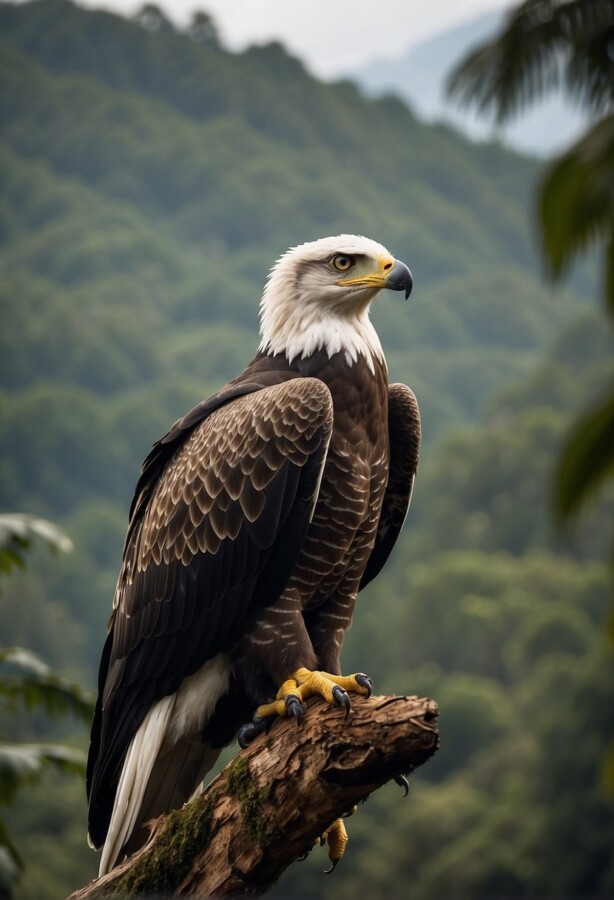
The Crowned Solitary Eagle, Harpyhaliaetus coronatus, is a formidable raptor endemic to South America. Its plumage is primarily silvery grey with a contrasting black tail, marked by a prominent white band and tip. A distinctive crest of darker feathers, the crowned eagle, a characteristic from which its name derives, adorns its head. Biologists note the yellow tinge on its legs and cere, contributing to its unique identification.
Taxonomically, it was once thought to align closely with harpy eagles. However, molecular analyses have elucidated a closer relationship to the genus Buteogallus, particularly paralleling the Great Black Hawk, Buteogallus orbiting. This eagle occupies a niche environment, favoring open or semi-open terrains to exercise its considerable hunting prowess.
Conservation alarms have been raised for this species due to its declining population, with habitat loss and fragmentation being the chief culprits. The Crowned Solitary Eagle’s ecological significance, alongside its enigmatic appeal, underscores the urgent need for continued research and conservation measures to ensure its survival.
Black Solitary Eagle

The Black Solitary Eagle (Harpyhaliaetus solitarius) is a less-known raptor that thrives in solitude, favoring expansive forests and rugged terrains from Mexico to Argentina. It is characterized by its largely dark gray plumage, with a white band and tip on its tail, distinguishing it from other eagles. The species exhibits sexual dimorphism; females typically have a slightly browner shade than males. These eagles maintain a low profile, often making them challenging to study.
Their sharp vision, with yellowish-brown eyes, coupled with their robust bodies, makes them formidable hunters. They prey on various animals, including small mammals and birds. While not critical, their conservation status warrants attention due to habitat loss and other human-induced factors. Tracking their numbers is difficult, as they reside in low-density populations and lead a discreet lifestyle.
FeatureDescriptionSizeOne of the larger eagle speciesHabitatPrefers forests and mountainous regionsColorationDark gray with distinct white tail markingsNestingSolitary, with sparse nest sightingsDietCarnivorous, preys on small to medium-sized animalsConservationNoted concerns due to deforestation and changes in land use.
By understanding species like the Black Solitary Eagle, conservationists can better safeguard these avian predators, ensuring their role in ecosystem balance is preserved.
Black-Chested Buzzard-Eagle

The Black-chested Buzzard-Eagle is a powerful bird of prey found in the open areas of South America, flying high with an impressive wingspan that showcases its mastery of flight. Distinctive gray upperparts and a namesake black chest characterize this eagle. The Black-chested Buzzard-Eagle inhabits regions where sparse trees provide ample opportunity for nesting.
Nesting is conducted in solitude; these eagles are largely solitary creatures. They build their nests in trees and benefit from elevated positions to survey their domains. The beak and talons of the Black-chested Buzzard-Eagle are robust, indicative of their predatory capabilities. In flight, they display broad wings and a relatively short tail suited to their open habitat hunting style.
These eagles are categorized by their bodied legs, clad entirely with feathers, a feature that can be seen as they soar overhead. Often found in isolated or less populated areas, the Black-chested Buzzard-Eagle plays a crucial role in its ecosystem, controlling rodent populations and thus contributing to ecological balance.
Harpy Eagle
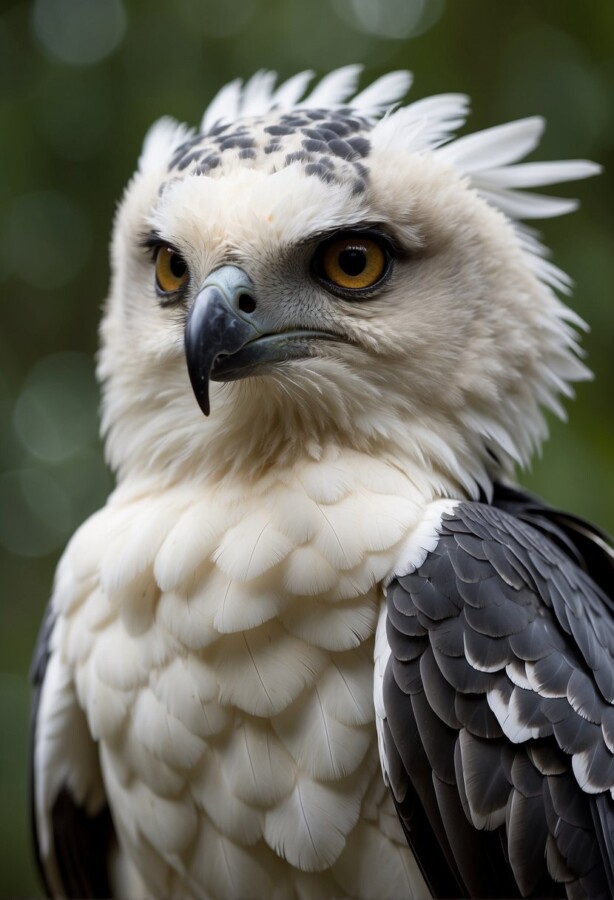
The Harpy Eagle (Harpia harpyja), native to the tropical forests of South America, is a formidable avian predator. Its body is adapted for strength, and its large paws, comparable to the size of bear claws, are instrumental in capturing prey such as monkeys and sloths.
This raptor’s wingspan extends up to 2 meters, facilitating maneuverability through dense canopies where it reigns as a skilled hunter. A defining characteristic of the Harpy Eagle is its striking feathered crest, which it raises when alert. Its considerable size, marked by a broad and muscular build, ranks the Harpy Eagle among the world’s largest and most powerful eagles.
Adapted to life high in the emerald realms of towering trees, the Harpy Eagle plays a vital role in the balance of its ecosystem. Despite its prowess, deforestation threatens their existence, emphasizing the need for comprehensive conservation efforts to ensure the survival of these majestic birds. By protecting their habitat, we safeguard the Harpy Eagle and the intricate web of life within the tropical forests they dominate.
Papuan Eagle

The Papuan eagle, scientifically known as Harpyopsis novaeguineae, is a raptor of substantial size native to New Guinea. This bird of prey is symbolic of the region’s diverse avian life, with a presence rooted in the dense rainforest habitats of the island. Sexual dimorphism is typically observed, with the female being up to 34% larger than the male. Adult Papuan eagles measure 75 to 90 cm long, embodying prowess with broad wingspans ranging from 121 to 157 cm.
The species is regarded as vulnerable, facing deforestation and habitat disturbance threats. Conservation efforts prioritize the protection of their habitat to maintain the ecological balance in which the Papuan eagle plays a pivotal role as a top predator. Their elusive nature and preference for expansive, untouched forest regions complicate research, hence comprehensive data on population numbers is limited. Focused studies and conservation initiatives are critical for ensuring the survival of this magnificent raptor.
Philippine Eagle
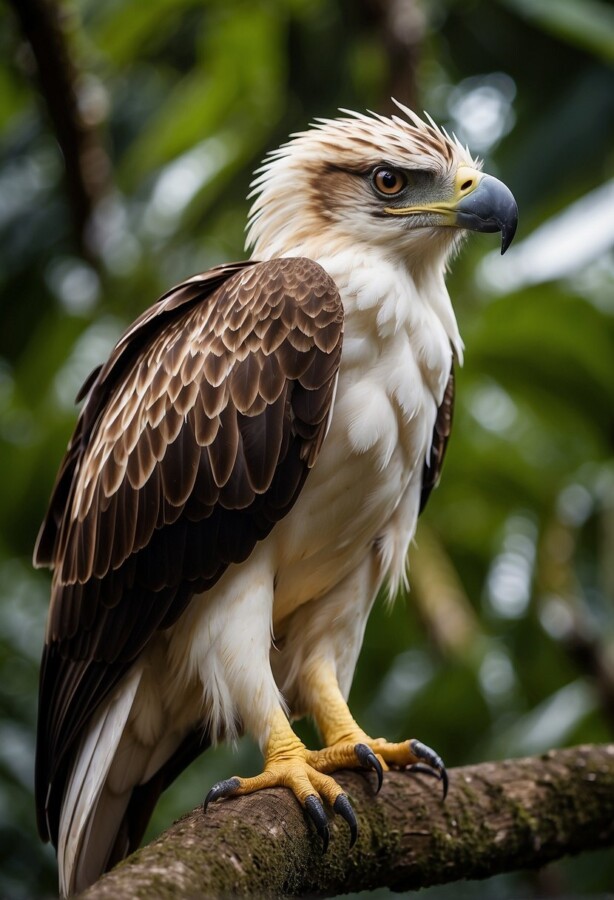
The Philippine Eagle (Pithecophaga jefferyi), with its lengthy body and extensive wing area, is recognized as among the largest eagles. Its nape boasts a distinctive shaggy crest of brown feathers, complementing its dark facial area and creamy-brown crown. A stark, dark brown coloring graces its dorsal aspect, whereas its underside features a stark white. Remarkably adapted for life in dense forest canopies, they exhibit superb flight skills, aided by their impressive 184 to 220 centimeters wingspan.
With an estimated population of 250-600 individuals, these raptors are on the brink of extinction. They are deemed critically endangered, largely due to deforestation and habitat disruption. This species is a symbol of Philippine wildlife and a critical component of its ecosystems, serving as apex predators.
They predominantly hunt medium-sized animals, such as flying lemurs and monkeys, illustrating their role in maintaining the balance of their habitat. Their longevity is notable, with wild individuals possibly reaching up to 60 years.
See Related: Best Greenhouse Floors to Buy Today
Black Eagle

The Black Eagle (Ictinaetus malaiensis) stands out for its predominantly dark plumage, which contrasts sharply with lighter-colored raptors. It prefers the dense canopy of tropical forests and graces the skies from the Himalayan foothills to Southeast Asia, including the Indian subcontinent and Sri Lanka. This species thrives in subtropical climates, which is evident in its distribution across varied elevations and regions.
Physical Characteristics:
- Size: Medium-sized eagle with a body length of 70-80cm.
- Wingspan: Ranges from 178 to 220cm.
- Flight: Soaring habit, utilizes updrafts along mountain ridges.
Habitat:
- Prefers undisturbed forest regions.
- Known to inhabit elevations up to 2200 meters.
Remarkable for its adept hunting skills, the Black Eagle preys primarily on birds, small mammals, and reptiles, showcasing its ecological role as a forest predator. This raptor constructs large nests on cliff edges or tall trees, underscoring its adaptation to forest living. Conservation efforts emphasize habitat protection, as deforestation significantly threatens its survival. The Black Eagle, with its majestic presence and specialized role, underscores the critical need for forest conservation.
Lesser Spotted Eagle

The Lesser Spotted Eagle (Clanga pomarina) is a medium-sized raptor distinguished by its small head and bill. One of its defining characteristics is the plumage: adults exhibit a pronounced two-tone pattern with dark flight feathers sharply contrasting against a paler body. This species differs considerably from its relative, the Greater Spotted Eagle, in size and paleness.
Juveniles notably differ from adults, presenting bold white bars on the back and wings and lighter coloring on the upper tail. The species inhabits a variety of landscapes across Europe and Asia, preferring forested regions near water sources. Conservation efforts are pivotal, as habitat loss threatens their populations.
In flight, a keen observer may notice the Lesser Spotted Eagle’s double white underwing pattern, distinguishing it from other eagles. While not directly aided by The Peregrine Fund, the Lesser Spotted Eagle benefits from overarching conservation programs targeting habitat preservation essential for numerous raptor species.
Indian Spotted Eagle

The Indian Spotted Eagle (Aquila hastata) stands notable for its presence in the Indian subcontinent. Typically, this bird extends to a length of 60 cm with a wingspan spanning approximately 150 cm. Identifiable by its dark brown plumage and paler spots, it thrives primarily in the Nal Sarovar Bird Sanctuary, Gujarat, among other locations.
Habitat & Behavior:
- Resides: Open forests, woodlands, and farmland.
- Diet: Carnivorous; adept at hunting small mammals and birds.
- Nesting: Large platform nests in trees.
Conservation Status:
- IUCN Status: Vulnerable due to habitat loss and degradation.
Recognizing its importance, conservation efforts are vital for sustaining the habitats and populations of the Indian Spotted Eagle. Its ecological role as a predator underlines the interconnectedness of species within the subcontinent’s diverse ecosystems.
Tawny Eagle

The Tawny Eagle (Aquila rapax) exhibits a predominantly tawny-colored plumage on its upper parts, complemented by darker flight feathers. Adult Tawny Eagles span a size range of 65 to 72 centimeters in length, with a substantial wingspan of 1.72 to 1.85 meters. Sexual dimorphism is subtle, with females usually larger than males. Heavily feathered legs, characteristic of the subfamily Aquilinae, distinguish them as booted eagles.
Ecology and Behavior: Inhabiting various terrains across Africa and parts of Asia, these birds of prey showcase versatility in both hunting and habitat suitability. They are not strict dietary specialists; their prey includes small mammals, birds, and carrion, indicating opportunistic feeding patterns.
Conservation Status: Global populations are facing declines due to habitat destruction, human-wildlife conflict, and changes in prey availability. Conservation efforts focus on habitat protection and mitigating factors leading to their decreased numbers.
Reproduction: Tawny Eagles are solitary breeders, usually nesting in large trees. They exhibit considerable fidelity to nesting sites, returning annually to the same location. The clutch typically consists of 1 to 3 eggs, and both parents are involved in the upbringing of their young.
Spanish Imperial Eagle

Native to the Iberian Peninsula, the Spanish Imperial Eagle, Aquila adalberti, is recognized by its relatively large size and distinctive white “epaulettes” on its shoulders. It is a bird of significant conservation concern, with its population limited to Spain and Portugal. Adults exhibit a dark brown plumage contrasted by a paler cream-colored head and neck. This species prefers forested habitats adjacent to water bodies and is often found in dehesas and open woodlands in its range.
Key Characteristics:
- Scientific Name: Aquila adalberti
- Habitat: Woodlands, dehesas, near water
- Average Lifespan: 16.4 years, can live up to 31 years
- Conservation Status: Threatened, with habitat loss and fragmentation posing major threats
Their diet mainly consists of rabbits, which makes them susceptible to population declines should their prey experience a downturn. They also feed on other medium-sized mammals and occasionally birds. Conservation programs have been crucial in preventing their decline, emphasizing habitat protection, and reducing human-caused losses.
Juveniles are distinguishable from adults by their rufous to pale brown coloration with dark flight feathers. The Spanish Imperial Eagle’s call is a clear and repeated “owk.” Its continued existence is largely due to vigorous conservation efforts to protect this majestic raptor.
Greater Spotted Eagle

The Greater Spotted Eagle (Clanga clanga), often nested within the diverse Accipitridae family, exemplifies the notable characteristics of booted eagles. This bird of prey displays a plumage predominantly dark brown and a notable white marking resembling a comma on the underwing, aiding differentiation from its counterpart, the Lesser Spotted Eagle. Distinguished by feathers extending down its legs, this species occupies a geographical range spread across Europe and Asia, with winter migrations leading to parts of Africa and India.
Habitat selection tends to be diverse; however, wetlands, remote forested areas, and river valleys are preferred for nesting and hunting. With a diet primarily composed of small mammals and other birds, the Greater Spotted Eagle’s hunting prowess is evident; they utilize their broad wings proficiently in soaring and sudden dives to capture prey. Conservation status is particularly relevant for this species; habitat loss and human interference have led to declining numbers, marking it as vulnerable and necessitating focused conservation efforts.
Steppe Eagle
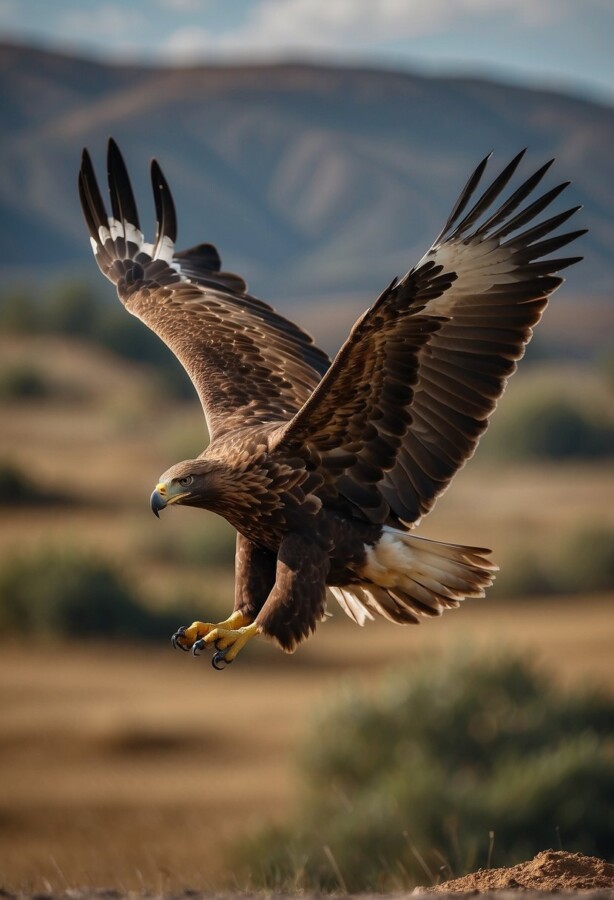
The Steppe eagle (Aquila nipalensis) stands out within the family Accipitridae due to its size and the distinct feathering on its legs, a characteristic of the booted eagle subfamily, Aquilinae. Adults of this species can be identified by their brown plumage and lighter feathers on the nape and crown, offering an almost majestic look. Inhabiting open grassland and semi-desert regions, they are known for their opportunistic feeding habits, often scavenging but hunting small mammals and birds.
WingspanWeightLifespan165-215 cm2-4.9 kgUp to 41 years
Migration patterns are remarkable, with these raptors traveling considerable distances between their breeding and wintering grounds. Conservationists have categorized the Steppe eagle as “Endangered,” with declining numbers due to habitat loss and other anthropogenic factors. Conservation efforts focus on habitat protection, anti-poisoning measures, and awareness campaigns to ensure the survival of this species.
See Related: Is a Bird a Consumer? Here’s What to Know
Eastern Imperial Eagle

The Eastern Imperial Eagle (Aquila heliaca) is a notable raptor within the family Accipitridae. Characterized by its formidable size, the species displays a wingspan of up to 7.2 feet. Adults donning a dark brown plumage contrasted by a paler head and nape. These distinctive birds of prey breed in southeastern Europe, stretching across West and Central Asia. They exhibit migratory behavior, traveling to winter in regions such as northeastern Africa, the Middle East, and South and East Asia.
Identification:
- Size: Large raptor
- Wingspan: Up to 7.2 feet
- Plumage: Dark brown body, paler head, and nape.
Habitat:
- Breeding: Forested areas in Southeastern Europe, Central Asia
- Wintering: Northeastern Africa, Middle East, South and East Asia
Notably, juveniles vary in appearance, marked by a sandy brown color with pronounced streaks and a pale rump that stands out against the dark tail and flight feathers. Efforts to conserve this species have been ongoing, including establishing the Eastern Imperial Eagle Working Group. Conservationists continue to study the taxonomy of this bird, noting that it was once considered to share a subspecies with the Spanish Imperial Eagle. However, current categorization acknowledges them as distinct species.
Gurney’s Eagle

Gurney’s Eagle (Aquila gurneyi) is a raptor that commands the skies over lowland and foothill forests and disturbed areas in its habitat range. This bird sports dark brown to black plumage, featuring paler undersides on its flight feathers. With a body length of approximately 74-86 cm and a wingspan of 1.65 to 1.9 m, it is a large species but considered mid-sized among its genus.
Identification:
- Plumage: Mostly dark brown to black
- Tail: Long and rounded, unlike the Wedge-tailed Eagle’s
- Wings: Broad with a flat soaring profile, ‘fingered’ tips
- Size: Body length 74-86 cm; wingspan 1.65-1.9 m
Physical Traits:
- Head and Beak: Pronounced size
- Eyes and Legs: Yellow
- Cere: Gray
Juveniles display a mottled mix of brown, gray, and buff on their backs and wing coverts, with a lighter brown head and underparts, gradually fading to the adult plumage over time. Gurney’s Eagle is distinguished by its powerful flight, often observed as a solitary figure or in pairs unless in the presence of abundant food sources.
Wahlberg’s Eagle

Wahlberg’s Eagle (Hieraaetus wahlbergi) is a medium-sized raptor indigenous to sub-Saharan Africa, with distinctive migratory patterns across the woodlands and savannas. It is identified by a smaller head and beak relative to larger eagle species and exhibits a unique squared silhouette due to its short crest. Its plumage predominantly appears in chocolate-brown, with some individuals displaying paler morphs.
In their habitat, these eagles are versatile hunters. Their diet spans a diverse range, with a preference for birds, including other raptors, as well as reptiles like lizards, snakes, and small mammals. Rarely will Wahlberg’s Eagles also consume invertebrates such as termites and beetles. They share a clade with close relatives, including the Ayres’s Hawk Eagle and the Little Eagle.
Morphology:
- Common Morph: Dark, rufous to dark brown with pale edges on wing-coverts
- Other Morphs: Pale and intermediate
Diet:
- Primary: Birds (including other raptors)
- Secondary: Reptiles, small mammals
- Occasional: Invertebrates
This species is a seasonal migrant, making movements that align with prey availability and breeding conditions. It carries the name of Swedish naturalist Johan August Wahlberg, honoring his contributions to natural history. Conservationists monitor Wahlberg’s Eagle as a species reflective of ecological changes, ensuring that this agile predator remains integral to Africa’s diverse avian community.
Golden Eagle

The Golden Eagle (Aquila chrysaetos) reigns as a formidable raptor in North America, boasting one of the largest body sizes and exceptional speed and agility in flight. The lustrous gold-hued plumage that adorns their head and neck area and their robust beak and talons underscore their hunting expertise. These eagles primarily target small mammals, such as jackrabbits, for their prey.
In contrast to the fish-preferential Bald Eagle, Golden Eagles have broader culinary tastes. They often hunt in open or semi-open areas. They utilize their expansive wings, up to 2.3 meters in wingspan, to ride thermal currents, facilitating energy-efficient soaring.
Uniquely adapted, these birds exhibit territorial fidelity, with some pairs maintaining the same area for successive generations. As an apex predator and a symbol of wild spaces, the golden eagle possesses an important ecological role and is emblematic of conservation efforts worldwide.
Booted Eagle

The Booted Eagle (Hieraaetus pennatus) presents an intriguing case of morphological diversity within raptors. With a size comparable to the common buzzard, this medium-built bird exhibits dimorphism with two distinct plumage types. The species typically weigh 510-770 grams for males and 840-1,025 grams for females, showcasing sexual dimorphism. Their wingspan ranges from 110-132 cm, striking a balanced figure in the sky.
Distinct by its feathered ‘boot’ legs, the Booted Eagle’s underparts differ according to morph: the pale form being more widespread than the dark. Despite size perceptions, their hunting prowess remains undiminished, creating a lasting impact on a variety of prey. Their habitat spans across Europe to Asia, migrating to Sub-Saharan Africa and the Indian Subcontinent during winter.
Habitat preferences are diverse, ranging from open woodland to steppes. Conservation status is relatively stable, yet environmental changes necessitate vigilant monitoring. This species offers key insights into raptor adaptability and ecological necessity, reflecting broader themes in avian conservation.
Wedge-Tailed Eagle

The Wedge-Tailed Eagle (Aquila audax) stands as Australia’s largest bird of prey and is notable for its significant presence across the Australian continent and Tasmania. These eagles are recognizable by their distinctive wedge-shaped tail and broad wingspan, which averages 2.3 meters. Adults boast dark plumage and feathered legs that extend down to their toes, exhibiting an adaptation for hunting and soaring over their diverse habitats.
Physical Characteristics:
- Size: They weigh 7.05 to 11.68 lbs (3.2 to 5.3 kg).
- Coloration: Primarily dark brown with a paler nape and a cream or pinkish bill.
- Eyes: Adults have brown eyes, complementing their sharp visual prowess.
This species is classified as “Least Concern” on the IUCN Red List, reflecting a stable population trend due to successful conservation efforts. With a diet that includes a variety of prey, such as rabbits, reptiles, and other small mammals, the Wedge-Tailed Eagle plays a crucial role in the ecosystem as a top predator.
African Hawk-Eagle
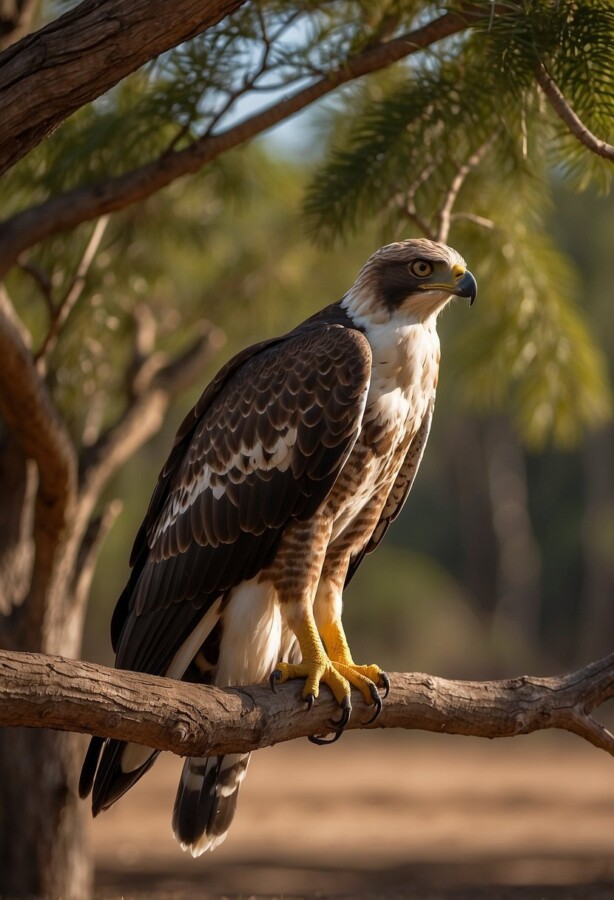
The African Hawk-Eagle (Aquila spilogaster), a prominent bird of prey, dwells in the semi-arid rangelands, savannas, and riverine forests across sub-Saharan Africa. Recognizable by its medium size and bold plumage pattern, it exhibits a dark-and-white theme, with its flight profile distinguished by contrasting brown and white underwings bordered by a thick black edge. The tail features a mostly pale gray canvas with a prominent dark bar at the end.
Key Identifiers:
- Size: Medium
- Underwing: Brown and white with black hind edge
- Tail: Pale gray with thick dark bar
- Immature Plumage: Rufous underparts, including underwings
This raptor is a proficient hunter, utilizing its acute vision and agility to prey upon small mammals and birds. Its similarity to the Bonelli’s eagle does not overshadow the fact that it is considered a distinct species. The African Hawk-Eagle plays a vital role in its ecosystem, managing populations of smaller creatures and contributing to the ecological balance.
Little Eagle

The Little Eagle (Hieraaetus morphnoides) is a bird of prey indigenous to Australia, distinguished by its comparatively small stature. Adults typically span no more than 55 cm long and weigh around 815 grams. This raptor exhibits sexual dimorphism, where females are often slightly larger than males. Their plumage boasts grey and brown colors, with paler undersides and a characteristic M-shaped marking visible when in flight.
Inhabiting diverse landscapes, they favor open woodlands, grasslands, and semi-arid areas yet avoid dense forests. The Little Eagle is versatile in its diet, preying on rabbits, small mammals, birds, and reptiles, showcasing opportunistic feeding habits. They employ remarkable hunting techniques, including high soaring and rapid, low flights to surprise their prey.
This species’ nesting behavior reveals a preference for tall trees, where they build large stick nests. Breeding season sparks aerial displays utilized for both courtship and territorial defense. Conservation efforts acknowledge the Little Eagle as a species of least concern, yet they remain under observation due to habitat alteration and human encroachment pressures.
See Related: Most Endangered Birds Around the World
Verreaux’s Eagle

Verreaux’s Eagle (Aquila verreauxii), often called the Black Eagle, is a large bird of prey endemic to sub-Saharan Africa. Residing predominantly in mountainous regions, this eagle prefers rock faces and cliffs for nesting. The species is distinguished by its stark black plumage, with contrasting white on its wings and back visible during flight. Mature Verreaux’s eagles are marked by a wingspan that can reach up to 2.1 meters, embodying strength and agility essential for hunting.
Physical Characteristics:
- Size: Length of 75-96 cm; Wingspan of 1.81-2.3 m
- Weight: 3-6 kg
Habitat: Prefers mountainous areas and rocky terrains.
Diet: Specializes in hunting rock hyraxes, supplemented by other small mammals and birds.
Conservation status of the Verreaux’s Eagle is currently assessed as Least Concern, though local declines are noted due to habitat loss and human disturbances. The specific mating rituals of the species include elaborate displays of aerial acrobatics. Conservation efforts aim to sustain the natural habitats of the Verreaux’s Eagle and mitigate threats stemming from human expansion.
Black-And-Chestnut Eagle
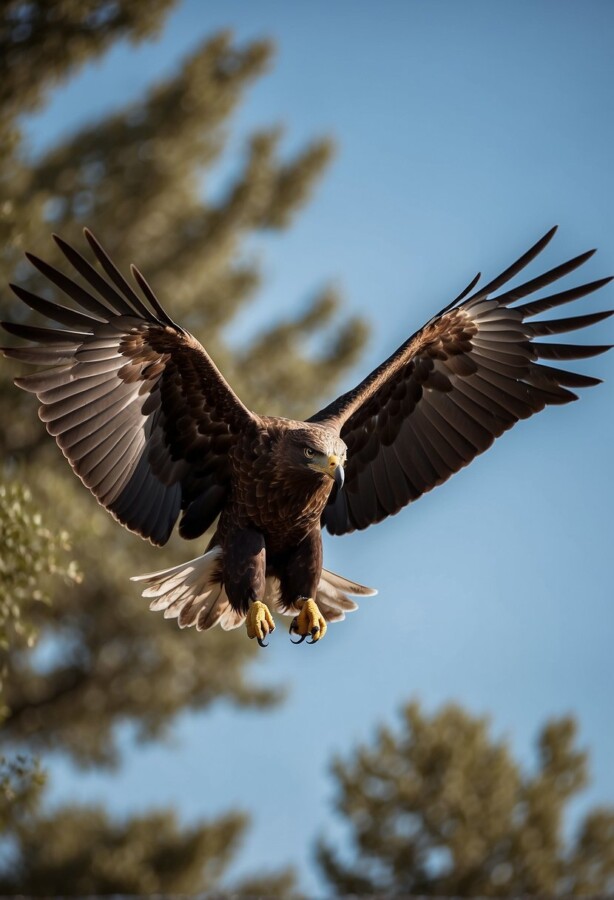
The Black-and-Chestnut Eagle (Spizaetus isidori) thrives in the cloud forests of South America, with its distribution extending from Venezuela to Argentina. This bird of prey is distinguished by its crested head, and adults exhibit a predominately black plumage with rich chestnut hues on their breasts and belly. Observers note the striking white patches in the wings and at the base of the tail during flight, as well as the chestnut coloration underneath the wings.
Juveniles present a marked contrast from adults, featuring a darker back, white underparts, and distinct banding on the wings and tail. While their appearance might resemble the pale morph variant of the Crested Eagle, Black-and-Chestnut Eagles showcase a uniquely shorter tail and a less pronounced barring pattern. This rare eagle species is of conservation concern owing to habitat loss and fragmentation. Conservationists stress the importance of preserving cloud forest habitats to protect this captivating and vulnerable raptor.
Ayres’s Hawk-Eagle

The Ayres’s Hawk-Eagle (Hieraaetus ayresii) is a distinctive bird of prey known for its compact, powerful build and striking black-and-white plumage. The underparts and underwing feathers showcase heavy black markings, making it unmistakable in flight against other hawk-eagles. Adults bear a small crest and have yellow eyes, a gray beak tipped black, and a white throat. Their habitat primarily encompasses thick woodlands and forests, where they soar frequently, searching for prey.
Juveniles differ slightly with a dark brown back and paler neck, yet they share the largely white underparts from throat to legs, adorned with sparse brown streaks. They vocalize with a loud, repetitive “kwee-ya,” useful for identification among the forest’s chorus. Regarding nesting preferences, Ayres’s Hawk-Eagles may build anew or occupy the abandoned nests of other large raptors.
They hold a relationship with species such as the Booted Eagle (Aquila pennata) and Little Eagle (Aquila morphnoides), with genetic studies indicating Wahlberg’s Eagle (Aquila wahlbergi) as a close relative. Conservation efforts emphasize the protection of their natural habitat to ensure the species’ survival, as they fulfill an essential role in the ecosystem by controlling populations of small mammals, birds, and reptiles.
Ornate Hawk-Eagle

The Ornate Hawk-Eagle (Spizaetus ornatus) stands out for its striking plumage and hunting prowess. It is a significant bird of prey in the tropical Americas. Its distinctive features include a crest of long black feathers, which can be erect when excited, and a robust body with barred underparts. Adults show an orange hue on the side of their heads, while piercing golden eyes enhance their formidable appearance.
Habitat: Primarily found in dense lowland and foothill forests, this eagle is well-adapted to life amidst the canopy. Sightings are common when the bird soars for prey mid to late morning.
Diet: As an adaptive feeder, the Ornate Hawk-Eagle preys on various birds and small to medium-sized mammals. Reptiles occasionally supplement their diet, although they are a less frequent choice.
Behavioral Traits:
- Call: Audible hiccupping whistles in flight denote its presence.
- Perching: Hunts use different forest levels for stalking prey.
- Plumage: Juveniles differ from adults, displaying less conspicuous coloration.
This eagle’s conservation status hinges on preserving its forest habitat, emphasizing the importance of ecosystem protection for survival.
Pygmy Eagle

The Pygmy eagle (Hieraaetus weiskei) is one of the smallest species. This raptor’s length ranges between 38 to 48 centimeters (15 to 19 inches), placing it at the lower end of the size spectrum for eagles. Primarily found within the Aquilinae subfamily, the Pygmy eagle demonstrates characteristics typical of eagles, such as robust talons and acute vision, despite its diminutive stature.
Key Features:
- Size: 38-48 cm (15-19 in)
- Subfamily: Aquilinae
- Habitat: Limited geographical distribution
Its habitat is restricted, which contributes to its lesser-known status among eagles. Conservation Status: Not widely studied, its conservation status remains unclear, necessitating further research to understand its ecological impact and to devise appropriate conservation strategies.
The distinctiveness of the Pygmy eagle lies not only in its size but also in its evolutionary significance within the eagle clade. As a lesser-known member of the raptor community, it presents unique opportunities for scientific study and conservation efforts.
Martial Eagle

The martial eagle, Polemaetus bellicosus, is a formidable raptor within the diverse Accipitridae family. It inhabits sub-Saharan Africa’s arid grasslands, scrublands, and sparsely wooded terrains and is noted for its impressive size. With a length of up to 96 cm (37 inches) and weight reaching 6.5 kg (14 pounds), it is one of the largest birds of prey globally.
Physical Attributes:
- Length: Up to 96 cm
- Weight: Up to 6.5 kg
Habitat:
- Region: Sub-Saharan Africa
- Environment: Dry grassland, Scrubland, Scattered woodland
Martial Eagles possess distinctive traits, such as sizeable long wings and “boots” of feathers covering their legs. Their predatory prowess is known to be quite versatile, feeding on a range of prey from small mammals to other birds. Due to their ecological significance as apex predators, ensuring their conservation requires diligent environmental management. Despite their grandeur, these raptors face habitat destruction and persecution challenges, underscoring the need for informed conservation efforts.
Black Hawk-Eagle

The Black Hawk-Eagle (Spizaetus tyrannus) is striking in the Neotropical bird of prey community. This bird’s defining plumage is predominantly black, complemented by checkered white patterns beneath its wings and banded white on its tail. Adults exhibit a sharp contrast with yellow tarsi and a yellow cere, the area at the base of the beak where it connects to the face. The species thrives in the dense lowland tropical forests, extending its range from Mexico through Central America to Argentina in South America.
Physical Characteristics:
- Length: 58-70 cm (23-28 inches)
- Weight: 900-1,300 grams (2-2.9 pounds)
- Wingspan: Broad with conspicuous white markings
The Black Hawk-Eagle is often identified by its loud, distinctive whistles in flight, typically in the late morning. When perched, their crested silhouette and the piercing quality of their gaze are notable. Its diet primarily consists of a variety of prey, including small mammals, birds, and reptiles, showcasing its versatility as a hunter.
Habitat:
- Preferred: Lowland tropical forests
- Distribution: Mexico to Argentina
Breeding practices are less observed, but this species is known for its solitary nature, except during mating season. Conservation-wise, the Black Hawk Eagle is not currently classified as endangered; however, habitat destruction poses a potential threat to its population, necessitating ongoing ecosystem protection efforts.
Long-Crested Eagle

The Long-Crested Eagle, identified by its scientific name, Lophaetus occipitalis, is a distinctive raptor native to sub-Saharan Africa. Characterized by its commanding presence, this eagle is instantly recognizable by its prominent shaggy crest, consisting of elongated feathers that rise from the back of its head. Typically clothed in dark plumage, adults exhibit a blackish-brown coloration that plays a role in their camouflage within their preferred habitats of woodland, plantations, and open forests.
Size and Morphology:
- Body length: Ranges from 55 to 65 cm
- Wingspan: Spans about 1.2 meters
- Tail length: Comparatively short
Behavior:
- Prefers perching for extended durations, an adaptation for its hunting strategy.
- Exhibits less frequent soaring behavior compared to other eagles.
Diet:
- Diet predominantly consists of small mammals and birds.
- Occasionally preys on insects and reptiles.
The Long-Crested Eagle’s vocalization is a distinctive, powerful “kweeeeya,” serving both as a territorial call and a form of communication during the breeding season. Easy to distinguish in flight, the Long-Crested Eagle has a notable wing pattern—considerable white under the wings—which differs from the darker coloration seen when the bird is perched. This eagle’s ecological role is crucial in controlling small mammals’ population and maintaining the balance within its ecosystem.
Crowned Hawk-Eagle

The Crowned Hawk-Eagle (Nisaetus coronatus), a raptor of formidable prowess, thrives across diverse habitats ranging from dense evergreen forests to open savannas. Its preference for forested ravines and woodland gorges underlines a versatile nature. Characterized by prominent head crests, these eagles exhibit a robust build with a wingspan that reinforces their mastery of the skies.
The diet primarily includes mammals and birds, underscoring their apex predatory status. Habitat-wise, they exhibit adaptability, settling in environments as distinct as riparian woodlands and montane forests. These raptors are noteworthy for their complex life cycle, which includes intricate courtship displays and a protracted nesting period. Conservation efforts prioritize habitat preservation, given the increasingly fragmented nature of their ecosystems.
Black-and-white Hawk-Eagle

The Black-and-White Hawk-Eagle (Spizaetus melanoleucus) resides in the lowland tropical forests and exhibits a distinctive contrast in its plumage, as the name suggests. The body measures approximately 50-60 cm (20-24 in), with a wingspan reaching 117 cm (46 in). Weighing around 850 g (30 oz), it sports a striking white head, neck, and underparts. A black mask-like feature and a short black crest characterize the head, and the raptor’s back features blackish feathers.
As a rare species, their behavior in the wild remains somewhat of an enigma, with much left to learn about their biology. The Black-and-White Hawk-Eagle is classified under the least concern category by conservation status, yet its rarity underscores the importance of ongoing research and habitat preservation. They are predominantly solitary birds, often unseen until in flight when their black upper parts are contrasted sharply by the bright white beneath and a white leading edge on the inner wings stands out against the darker feathers.
Cassin’s Hawk-Eagle
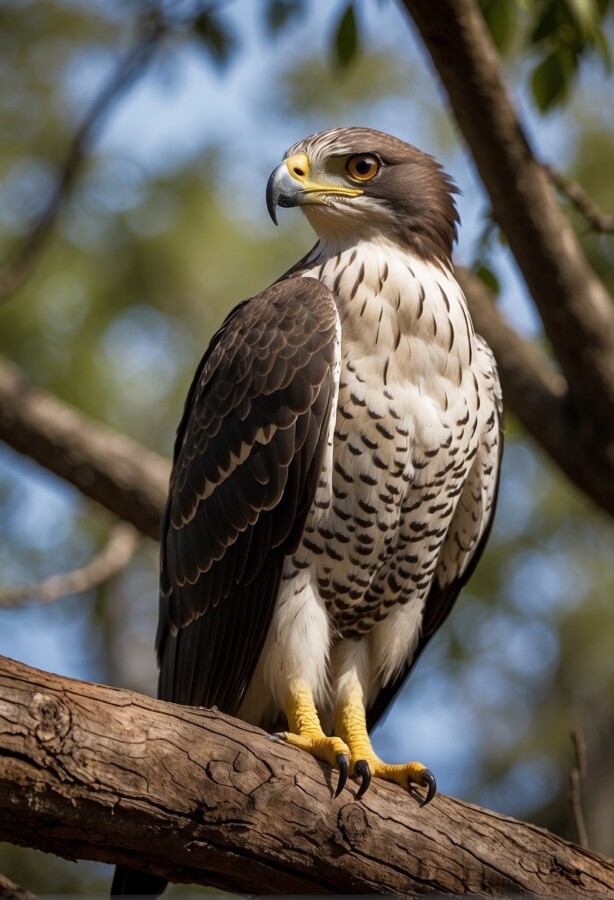
Cassin’s Hawk-Eagle (Aquila africana), a small raptor in the Accipitridae family, displays a robust physique, notable for its feathered legs characteristic of the Aquilinae subfamily. This eagle thrives in the dense canopies of the western and central African rainforests, ranging from Sierra Leone to Uganda. It prefers primary and secondary forests and can be found at altitudes up to 2,300 meters.
Physical Characteristics:
- Size: Compact, with short, rounded wings.
- Coloration: Dark brown upperparts with white spots; underparts contrast starkly with black flanks and white regions.
Cassin’s Hawk-Eagle is typically elusive in behavior, seldom soaring in the open. It’s skilled at navigating the forest understory, enabling it to ambush birds and tree squirrels, its primary prey. Vocalizations include a distinctive “kwe-kwe-yaaa” and a rising whistle.
Habitat and Distribution:
- Range: Western to west-central Africa.
- Population: Estimated 1,000 to 10,000 individuals.
- Conservation Status: Faces threats due to deforestation and habitat fragmentation.
Understanding the Cassin’s Hawk-Eagle contributes to appreciating Africa’s avian biodiversity and the significance of forest conservation.
Bonelli’s Eagle

Latin Name: Aquila fasciata
Bonelli’s eagle is a predator found in diverse habitats, typified by its medium size compared to other eagles. Boasting a wingspan ranging from 150 to 180 centimeters, it displays sexual dimorphism with females being larger. They exhibit a dark brown plumage, with a lighter, golden-brown hue warming their head and neck area. This type of eagle is distinguished by remarkable flying capacities, afforded by its long and broad wings and a short tail aiding swift maneuvers.
It inhabits a broad range of landscapes, from open, dry terrains to woodlands close to wetlands, showing a preference for rugged environs that facilitate hunting. Its geographical spread extends over the Mediterranean into Asia.
Bonelli’s eagle feeds predominantly on small—to medium-sized birds and mammals, capturing them with powerful talons after stealthy glides or high-speed pursuits. Unfortunately, this species is threatened, with habitat loss and human interference as principal contributors. Conservation efforts are imperative for keeping Bonelli’s eagle in its natural habitat.
Crested Eagle

The crested eagle (Morphnus guianensis), a significant bird of the Neotropical realm, stands as a singular member of its genus. Distinguished by a robust body, this eagle’s length may extend to 89 cm, while a wingspan reaching 176 cm showcases its grandeur. Adults typically weigh up to 3 kg, embodying a harmonious blend of might and aerial agility. Known for their preference for dense rainforests, crested eagles range from Southern Mexico to Northern Argentina.
Identification: The species exhibits a striking crest, contributing to its namesake, alongside dark plumage with lighter ventral coloring. Juveniles are often confused with immature Harpy eagles due to similarities in their feather patterns.
Diet: Adapted as a formidable predator, the crested eagle’s diet varies, including a variety of arboreal mammals and birds. The eagle demonstrates remarkable hunting adaptability, though exact prey preference may fluctuate by individual.
Conservation: While current population data are not comprehensive, habitat destruction poses a persistent threat to the crested eagle. Preservation initiatives focus on safeguarding the rainforest ecosystems that sustain this species and numerous others within the biodiverse tracts they inhabit.
Bald Eagle

The Bald Eagle (Haliaeetus leucocephalus), the United States national bird, is an eminent raptor indigenous to North America. It presents a distinctive and majestic appearance with a powerful body, a wingspan reaching 7.7 feet, and a contrasting white head and tail against a chocolate-brown body and wings. Occupying habitats near large bodies of open water, Bald Eagles subsist mainly on fish, which they deftly snatch from the water with their sharp talons.
Mature after about four to five years, these eagles form monogamous pairs and construct some of the largest nest structures among birds, often reusing and adding to them each year. The preservation efforts in the US, following a decline due to pesticides and hunting, have been successful, leading to their current conservation status of least concern, symbolizing a triumph for wildlife conservation.
Related Resources:
- Blue Birds: A Comprehensive Guide to Identification and Habitats
- Birds That Look Like Robins But Aren’t
- Most Beautiful Birds in the World


